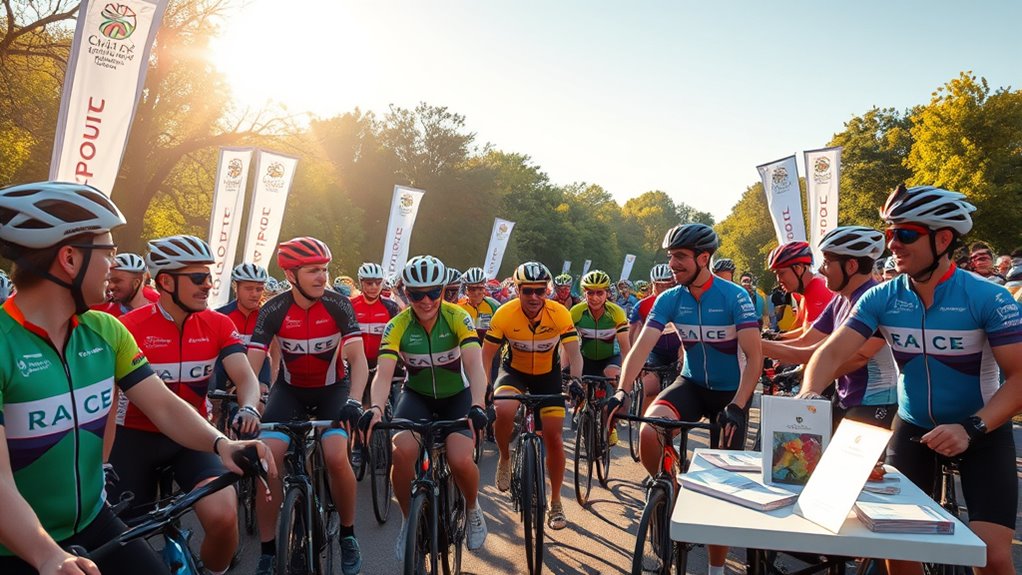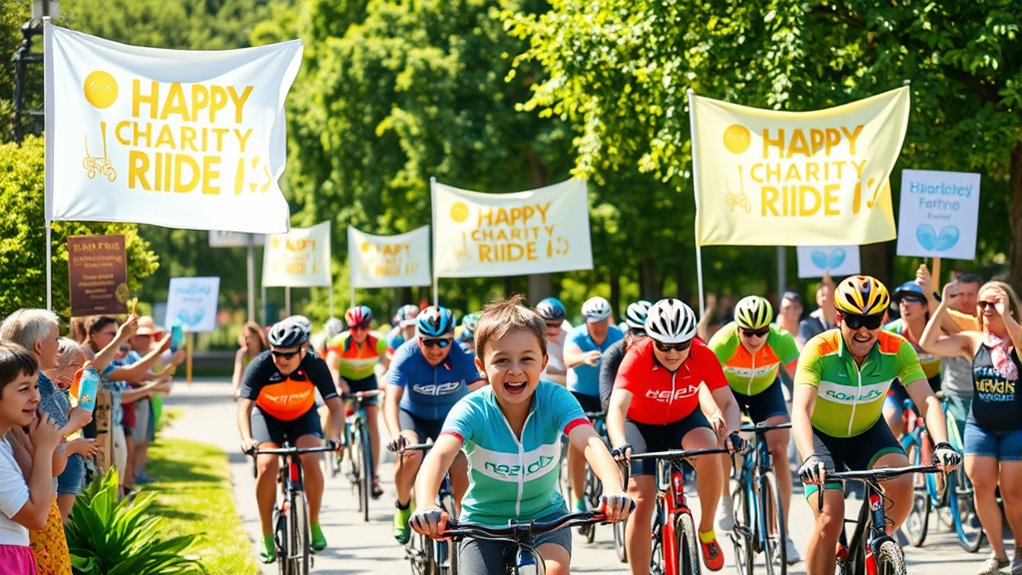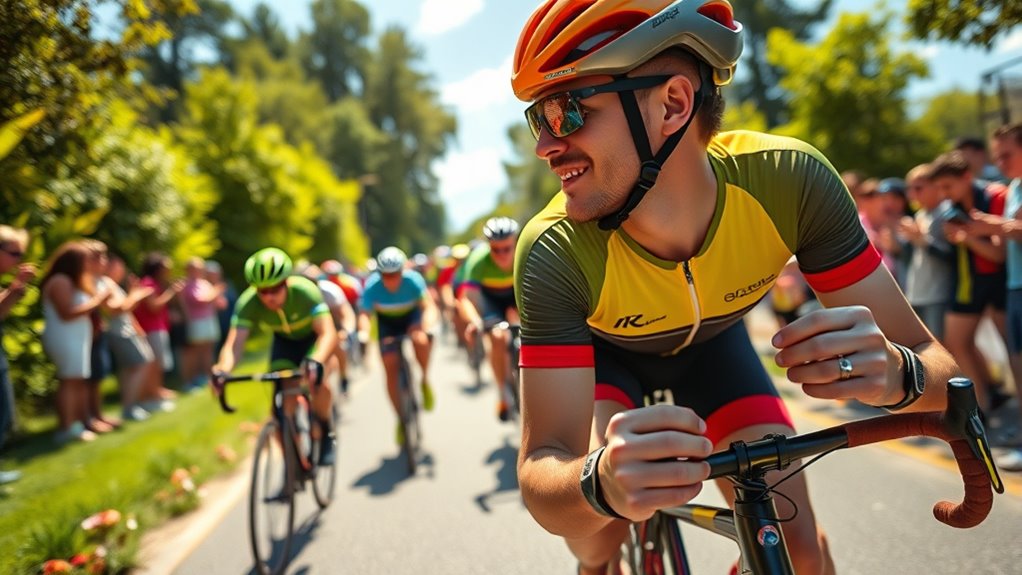Cycling for charity’s a fantastic way to stay fit while making a difference. To join or start a fundraiser ride, first, identify a cause that resonates with you and gather a team to help organize logistics and marketing. Promote the event, engage local businesses for sponsorships, and encourage participants to set fundraising goals. Finally, train consistently to prepare for the ride. There’s much more to discover about successfully planning and participating in these impactful events.
Key Takeaways
- Research local charity rides and events to find opportunities for participation or inspiration for organizing your own fundraiser ride.
- Assemble a dedicated committee to help plan logistics, marketing, and sponsorship for your charity cycling event.
- Set clear goals and choose a cause that resonates with your community to attract participants and support.
- Promote the event through social media, local partnerships, and email campaigns to maximize visibility and engagement.
- Encourage participants to create personal fundraising pages to amplify efforts and foster community involvement.
Benefits of Participating in Charity Rides

Participating in charity rides not only helps you stay fit but also connects you with your community. These fundraising events promote physical fitness, improving your cardiovascular health and reducing the risk of chronic diseases.
As you ride alongside others, you foster community engagement, creating a sense of camaraderie and shared purpose. You’ll also support meaningful causes, knowing that the funds you raise directly impact local or global initiatives, enhancing your sense of contribution.
Additionally, these rides present a personal challenge; setting goals for distance or fundraising boosts your self-esteem and motivation. Engaging in charity rides can even open networking opportunities with like-minded individuals and potential sponsors, paving the way for future endeavors. Furthermore, participating in such events can enhance your cultural intelligence by exposing you to diverse perspectives and encouraging collaboration across different communities.
Steps to Organize a Successful Fundraiser Ride

When you decide to organize a successful fundraiser ride, assembling a dedicated bike-a-thon committee is essential. Gather team members with diverse skills in logistics, marketing, and sponsorship to help with planning a bike-a-thon that runs smoothly.
Secure necessary permits and insurance, and pick a safe, well-marked course with various distance options for different skill levels.
Ensure you obtain the required permits and insurance while selecting a safe, well-marked course with diverse distance options for all skill levels.
Develop a marketing strategy using social media, local partnerships, and email campaigns to attract participants and donors. Encourage cyclists to create personal fundraising pages, offering incentives for top fundraisers to boost engagement. Additionally, consider reaching out to local businesses for financial assistance programs that can help support your event.
After the event, celebrate achievements, collect feedback, and analyze your fundraising performance against goals. This will help identify successes and areas for improvement for future rides.
Effective Fundraising Strategies for Cyclists

Organizing a successful fundraiser ride is just the beginning; effective fundraising strategies for cyclists can greatly enhance the impact of your event.
Start by utilizing crowdfunding software to streamline registration and donations, allowing participants to create personal fundraising pages and share them on social media. This promotes peer-to-peer fundraising and broadens your reach.
Engage local businesses as sponsors, offering them visibility on promotional materials to boost community involvement and financial support.
Encourage participants to set reasonable fundraising goals that match their networks. You could also offer tiered rewards for different donation levels to incentivize contributions.
Finally, plan post-event activities like celebratory gatherings or raffles to keep the momentum going and encourage additional donations after the ride. Additionally, consider setting savings goals that participants can work towards, which can further motivate them to raise funds for the cause.
Engaging the Community and Building Support

Engaging the community in your charity ride not only boosts participation but also cultivates a sense of belonging among riders.
By collaborating with local businesses for sponsorships and supplies, you can enhance community involvement and foster camaraderie toward your fundraising goal.
Hosting pre-ride events or meetups allows participants to connect, share motivations, and build excitement.
Utilize social media and local marketing strategies to reach potential riders and donors, increasing awareness and support for your cause.
Encourage participants to create personal fundraising pages, sharing their journeys to amplify community engagement.
This approach not only inspires others to contribute but also transforms your local bike ride into a unified effort for change, creating lasting connections within the community. Additionally, leveraging smart shopping strategies can help reduce costs for event supplies, maximizing your fundraising potential.
Tips for Training and Preparation

To successfully tackle your charity cycling event, it’s essential to prepare your body and mind through a well-structured training plan. Start training at least 8-12 weeks before the event, gradually increasing your ride duration and intensity.
Here are some tips to help you get ready for this good cause:
- Long Rides: Aim for at least one long ride each week, progressively increasing the distance to mimic race conditions.
- Diverse Terrains: Incorporate various terrains in your training rides to boost your adaptability and comfort.
- Strength and Flexibility: Add strength training and flexibility exercises to enhance your overall cycling performance and reduce injury risks.
Additionally, consider implementing regular maintenance on your gear, such as ensuring your pop-up camper is in good shape if you’re traveling to the event.
Track your progress with a cycling app or journal to stay motivated and focused on your goals.
Celebrating Success and Continuing the Impact

After your bike-a-thon, it’s essential to recognize everyone’s hard work and achievements. By sharing success stories and photos, you can keep the community engaged and excited for future events. Incorporating elements of mental health benefits can enhance the overall experience and motivate participants for upcoming rides. Let’s explore how to celebrate these accomplishments while sustaining that momentum moving forward.
Recognizing Participants’ Achievements
Recognizing participants’ achievements in fundraising rides not only boosts morale but also strengthens the sense of community among cyclists.
Here are a few effective ways to celebrate successes:
- Awards and Recognition: Celebrate top fundraisers during post-event gatherings, inspiring others to elevate their efforts in future rides.
- Personalized Thank-You Emails: Send personalized messages highlighting individual contributions and the total funds raised, reinforcing their impact and encouraging ongoing support.
- Share Success Stories: Post event photos and stories on social media and newsletters to keep the community connected to the mission and maintain momentum. Additionally, fostering a sense of community support can enhance participants’ commitment to future events.
Sustaining Community Engagement
While celebrating the success of a bikeathon is essential for building community spirit, sustaining that engagement requires ongoing efforts beyond the event itself.
Host post-event gatherings where participants can share their experiences, reinforcing connections and motivation. Recognize top fundraisers with prizes or shout-outs to encourage a culture of giving and community support.
Send thank-you communications to all participants and sponsors to maintain relationships, enhancing future involvement. Transparently share the total funds raised and their impact on the community, fostering trust among supporters.
Finally, gather feedback from participants to improve future rides, ensuring that their needs and preferences are prioritized. This continuous engagement will keep the momentum alive and inspire ongoing commitment to your cause. Additionally, consider implementing strategies from personal development resources to enhance participant satisfaction and involvement over time.
Frequently Asked Questions
How to Start a Charity Bike Ride?
To start a charity bike ride, you’ll want to gather a planning committee with diverse skills in logistics and marketing.
Choose a date and location, ensuring you secure permits and a safe route. Set clear fundraising goals and create a budget.
Promote your event through social media, local businesses, and email campaigns to boost engagement.
After the ride, celebrate and thank everyone involved while gathering feedback for future improvements.
How to Do a Bicycle Fundraiser?
Wondering how to pull off a successful bicycle fundraiser? Start by picking a date and location that excites you.
Next, set clear fundraising goals and create a detailed plan. You’ll want to utilize crowdfunding software for easy participant registration and donations.
Don’t forget to promote your event vigorously through social media and local businesses.
How Do I Start a Charity Fundraiser Event?
To start a charity fundraiser event, begin by assembling a planning committee with diverse skills.
You’ll need to secure permits and insurance for your location while establishing a timeline.
Set clear fundraising goals and a budget to measure success.
Craft a marketing strategy using social media and local sponsorships to draw participants.
Finally, create engagement opportunities, like personal fundraising pages and pre-event meetups, to build excitement and community around your cause.
How Do People Raise Money by Cycling?
Riding for a cause can turn your pedals into a powerful engine for change. You raise money by collecting pledges or donations based on the distance you ride.
Setting up a personal fundraising page makes it easy to share your mission with friends and family. Many cyclists also seek sponsorships from local businesses, creating a community bond.
Engaging your network through social media can amplify your efforts and inspire others to contribute.
Conclusion
Joining or starting a charity ride can transform lives, build communities, and ignite passions. You’ll connect with fellow cyclists, inspire change, and make a real difference. By training hard, fundraising smart, and engaging your community, you’ll not only achieve your goals but also create lasting memories. So, ride for a cause, ride for your friends, and ride for a brighter future. Embrace the journey, celebrate your successes, and continue to support those in need.









